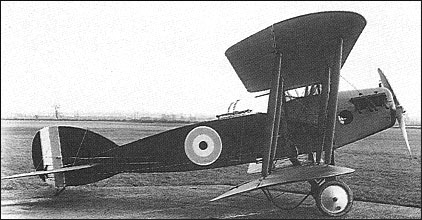|
| Known by the appellation of "Fighter" almost from its
birth, the F.2 series of two-seat fighter-reconnaissance
aircraft designed by Frank Barnwell was to join the
ranks of the true immortals of World War I. Designed
around the new 190hp Rolls-Royce 12-cylinder watercooled
engine, but with provision for the alternative installation
of the 150hp eight-cylinder Hispano-Suiza,
the F.2A had a single forward-firing synchronised
7.7mm Vickers gun and a Lewis gun of the
same calibre on a Scarff ring in the rear cockpit. The first
of two prototypes was flown on 9 September 1916, a
production contract for 50 aircraft having been placed
12 days earlier, on 28 August. Deliveries began early in
1917, but initial operational experience in April 1917
was disappointing, thanks to the use of incorrect combat
techniques. Confidence in the type was restored
when newly-evolved methods were proved successful.
Meanwhile, the improved F.2B had been evolved, the
51st and subsequent production aircraft being of this
standard, and delivery of the F.2B resulting in the withdrawal
from frontline use of the F.2A.
 | A three-view drawing (800 x 357) |
| WEIGHTS |
| Take-off weight | 1210 kg | 2668 lb |
| Empty weight | 783 kg | 1726 lb |
| DIMENSIONS |
| Wingspan | 11.96 m | 39 ft 3 in |
| Length | 7.87 m | 26 ft 10 in |
| Height | 2.89 m | 10 ft 6 in |
| Wing area | 36.14 m2 | 389.01 sq ft |
| PERFORMANCE |
| Max. speed | 177 km/h | 110 mph |
| Martin Giles, e-mail, 28.11.2009 03:41 Mr Rudnicki is correct about the combat technique. Also, at the time there was an (unfounded) belief that the Bristol suffered from a structural weakness and could not be thrown around with safety (J.M. Bruce). Incidentally the drawing seems to be based on a design development from July 1916 that was never built (I would really like to know who did the drawings for this entire collection!!!). Also the lower wing end plates were added to and removed from the second prototype and the wing gap faired over. reply | | leo rudnicki, e-mail, 29.04.2009 22:04 The incorrect combat technique refers to reliance on flexible defensive guns, the newly-evolved method was the attack with fixed forward firing gun. The WWII Defiant and Roc had only defensive guns. In fighter combat, going defensive is something you do before losing, attacking, something before winning. reply |
|
Do you have any comments?
|
| 
COMPANY
PROFILE
All the World's Rotorcraft
|







